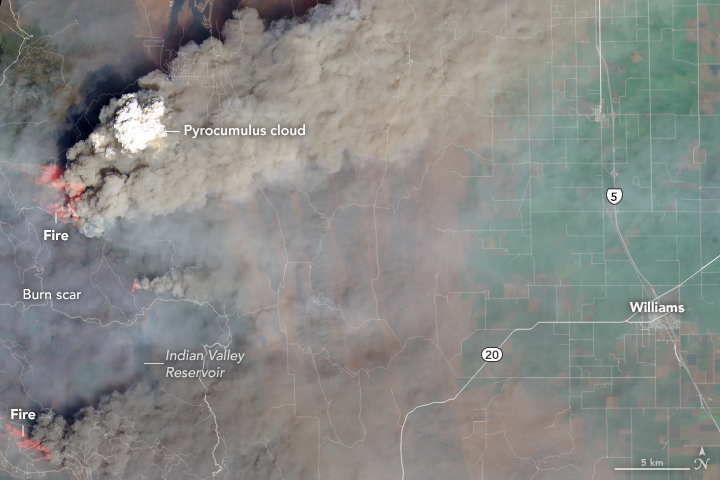
The Landsat 8 satellite captured the image above on August 6. You can see a dense column of smoke topped by a pyrocumulus cloud over California’s Ranch fire, part of the Mendocino Complex Fire, now the largest wildfire in the state’s history. Via NASA Earth Observatory.
NASA Earth Observatory wrote on August 9, 2018.
In July and August 2018, towering plumes of smoke have risen from several fires in northern California. Though heavy rains ended the lengthy drought that parched California, trees and vegetation killed during that dry spell still linger in California’s forests. With all that extra fuel priming the state’s forests for large fires, a period of hot and windy weather this summer made it extremely difficult for firefighters to maintain the upper hand.
One of the fires—the Mendocino Complex—surpassed the 2017 Thomas fire to become California’s largest fire on record. As of August 7, 2018, the fire had charred 1,200 square kilometers (460 square miles), an area about the size of New York City. Another blaze, the Carr fire near Redding, had torched more than 1,000 homes, making it California’s sixth most destructive fire on record. Several thousand firefighters are battling each of the large fires in California.
The heat generated by intense wildfires can churn up towering pyrocumulus and pyrocumulonimbus clouds, which lift smoke above the boundary layer, the lowest part of the atmosphere …
Scott Bachmeier, a research meteorologist at the University of Wisconsin-Madison, said:
Many of the larger fires in California have produced pyrocumulus clouds on an almost daily basis. While much of the smoke is being ejected to high altitudes and transported eastward across the Lower 48 states, some of it has been confined to the boundary layer, reducing visibility and affecting air quality near the fires.
Read more from NASA Earth Observatory
The West is burning up, and every state in the contiguous US can expect smoky skies this Wednesday as a result: https://t.co/67KH383jHr pic.twitter.com/2O70YW1TV8
— WeatherOptics (@weatheroptics) August 8, 2018
Bottom line: Space image of a pyrocumulus cloud – aka a fire cloud – over northern California.
from EarthSky https://ift.tt/2vxEnh8

The Landsat 8 satellite captured the image above on August 6. You can see a dense column of smoke topped by a pyrocumulus cloud over California’s Ranch fire, part of the Mendocino Complex Fire, now the largest wildfire in the state’s history. Via NASA Earth Observatory.
NASA Earth Observatory wrote on August 9, 2018.
In July and August 2018, towering plumes of smoke have risen from several fires in northern California. Though heavy rains ended the lengthy drought that parched California, trees and vegetation killed during that dry spell still linger in California’s forests. With all that extra fuel priming the state’s forests for large fires, a period of hot and windy weather this summer made it extremely difficult for firefighters to maintain the upper hand.
One of the fires—the Mendocino Complex—surpassed the 2017 Thomas fire to become California’s largest fire on record. As of August 7, 2018, the fire had charred 1,200 square kilometers (460 square miles), an area about the size of New York City. Another blaze, the Carr fire near Redding, had torched more than 1,000 homes, making it California’s sixth most destructive fire on record. Several thousand firefighters are battling each of the large fires in California.
The heat generated by intense wildfires can churn up towering pyrocumulus and pyrocumulonimbus clouds, which lift smoke above the boundary layer, the lowest part of the atmosphere …
Scott Bachmeier, a research meteorologist at the University of Wisconsin-Madison, said:
Many of the larger fires in California have produced pyrocumulus clouds on an almost daily basis. While much of the smoke is being ejected to high altitudes and transported eastward across the Lower 48 states, some of it has been confined to the boundary layer, reducing visibility and affecting air quality near the fires.
Read more from NASA Earth Observatory
The West is burning up, and every state in the contiguous US can expect smoky skies this Wednesday as a result: https://t.co/67KH383jHr pic.twitter.com/2O70YW1TV8
— WeatherOptics (@weatheroptics) August 8, 2018
Bottom line: Space image of a pyrocumulus cloud – aka a fire cloud – over northern California.
from EarthSky https://ift.tt/2vxEnh8

Aucun commentaire:
Enregistrer un commentaire